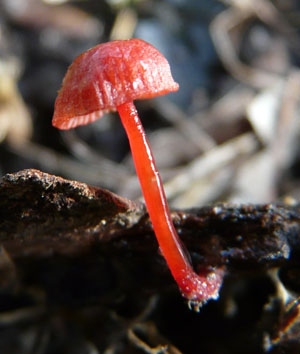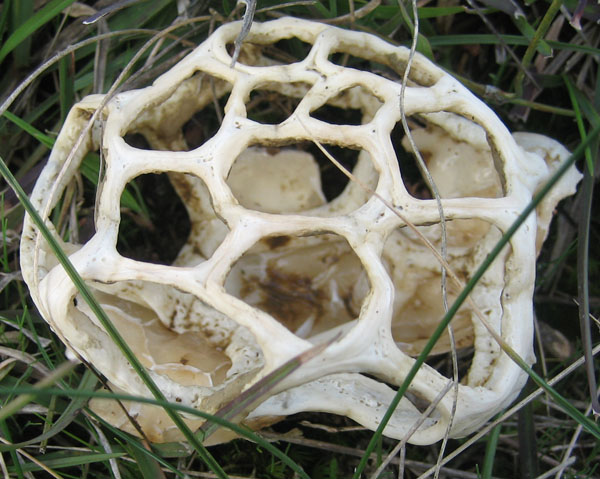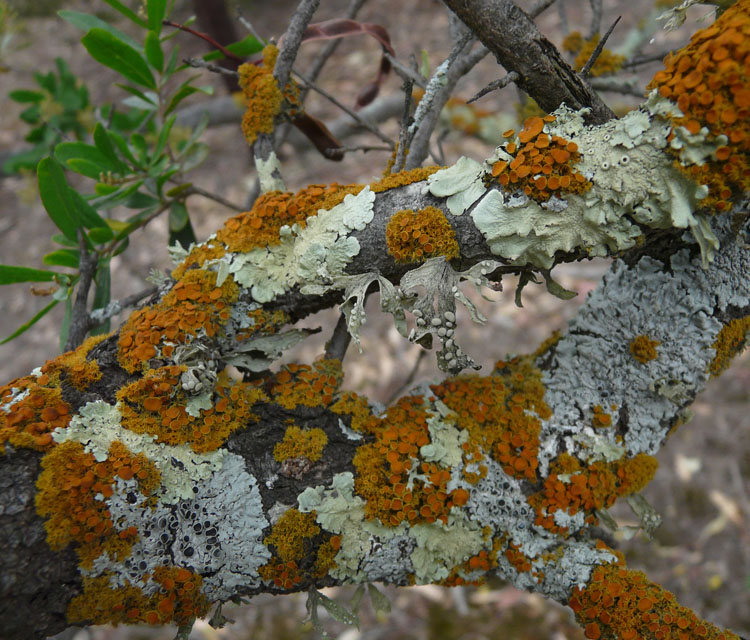
Fungi were once classified with plants, and because relatively few people take an interest in them they are still sometimes lumped together with plants: for example the Advisory list of rare or threatened plants in Victoria includes a few fungi. One of the main biological distinctions is that plants make their own food through photosynthesis, while fungi absorb it (in the form of organic molecules) through their cell walls. These molecules are obtained by one of four methods:
- By a mutually beneficial relationship with a plant, known as a symbiosis or mutualism. In the most common such relationship the underground filaments of the fungus basically act as an extension of the root system of the plant. Such fungi are described as mycorrhizal. In the species list they are indicated by an M in the "Food" column. For all species in the list the partner plant is a tree.
- By a mutualism with a photosynthesising algae or cyanobacteria which lives inside the body of the fungus. The combination is called a lichen.
- By decomposition of dead plant or animal material. Most fungus species fall into this category.
- Some fungi are parasitic on living plants, animals or other fungi.
The same species of fungus can sometimes use more than one of the above methods depending on circumstance.
A good introduction to the biology of fungi and lichens can be found on the website of the Australian National Botanic Gardens.

There are estimated to be between 50000 and 250000 species of fungus in Australia [Chapman 2009], the majority of which have not been named or described. It was estimated in 1997 that at the current rate of progress it would take more than 1000 years to fully catalogue Australian fungus species. This is because at the time there was only about one fungal taxonomist per 10 000 species of fungi (and fewer now), compared to one plant taxonomist per 200 species of plant, despite that fact that almost all species of Australian plant have already been catalogued.
Most fungus species are microscopic or at least do not have any features visible to the naked eye - examples include yeasts, moulds, plant rusts and smuts, mildew and ringworm. This site deals almost exclusively with larger fungi (macrofungi) which usually grow underground or in wood and produce spores on easily visible structures, such as mushrooms. For these types of fungi there are estimated to be about 10000 species in Australia, about half of which have been named. Tom May has observed that there are always more species of macrofungi at a site than there are plants (Scott et. al. 1997, chapter 5).
This fungi and lichen species list for Woodlands Historic Park contains 121 species so far. It is fairly easy to find species at the park which are not on the list - but even for the expert they can be hard to identify, and there are very few experts. It can be difficult to obtain descriptions even for the named species (see Fungi in Australia, section 1, page 4). A high powered microscope is needed to identify all but the most distinctive species.

The list includes unidentified species where they are visually distinctive or a reasonably detailed description exists. The hope is that it might be possible to recognize them again in the future, although in most cases there has been no microscopic examination and specimens have not been kept. Some descriptions (and photographs) are on this website but most are in unpublished reports of the Field Naturalists Club of Victoria Fungi Group, with just a few key points given in the table. The unidentified species may or may not have been previously described elsewhere.
There are fewer lichen species but identifying them is even harder, often requiring chemical analysis. There are a couple of species in the list but many other species occur as you can see in the lichen gallery. There are four main substrates in the park on which lichens grow: granite, basalt, soil and trees. However obvious lichens are rare on native trees in the park except on Sweet Bursaria. Each substrate carries different species of lichen although there is some overlap.
Is it Native?
Popular books about Australian plants invariably exclude species introduced by man, even those considered by botanists to be "naturalized". Fungi books, such as there are, often make no such distinction. One reason for this is that many fungus species are believed to be naturally cosmopolitan, and in other cases it is not known how natural the current distribution is. For example, the "Fairy-ring Champignon" (Marsmius oreades) is a cosmopolitan species which, according to the Fungimap book is probably not native to Australia. However in one of the most popular photographic guides to Australian fungi (Bruce Fuhrer's "A Field Guide to Australian Fungi") the only clue to its distribution that you will find is that it is "common in pastures, lawns and nature strips".
There are Australian species which have in the past been misidentified as a species from Europe. For example the Horse Dung Fungus was until recently considered to be the same as the northern hemisphere species Pisolithus arhizus or Pisolithus tinctorius (Leonard and McMullan-Fisher 2013). Other species may be similarly reclassified in future.
One can be fairly sure that a fungus is introduced if it is mycorrhizal with an introduced plant, since fungi are usually only mycorrhizal with plants of a particular genus. For example, there are at least three species of fungus in the park which are mycorrhizal with pine trees - Saffron Milk Cap, Suillus granulatus and a Rhizopogon species. It is interesting that although the pine tree species in question (Pinus radiata, Monterey Pine) is from North America, all but one of the 28 fungus species that occur with it in the southern hemisphere are from Europe, where they are mycorrhizal with other species of Pinus (Read 1998, p. 333). In Australia's case this is explained by the fact that the Monterey Pine was first imported to Australia in 1857 as a growing plant from Kew Gardens in England and presumably brought some fungi with it.
Several fungus species mycorrhizal with Monterey Pine have in fact switched hosts to an Australian tree, Myrtle Beech, in some locations. They could therefore be described as the fungal equivalent of environmental weeds, although their possible impact on native species is unknown and there is no known way of controlling them. Myrtle Beech does not occur at Woodlands Historic Park, and neither do the fungus species as far as I know.
In contrast to mycorrhizal species, most introduced fungi that live on dead organisms presumably find it easier to become naturalized in Australia. There are however fungi that specialize on, for example, pine needles (Thelephora terrestris) or pine wood (Gymnopilus dilepis). These would probably have trouble surviving in the absence of introduced trees.